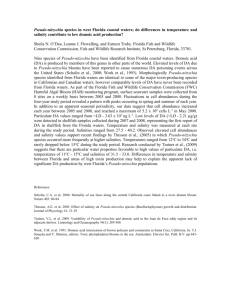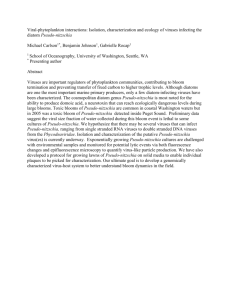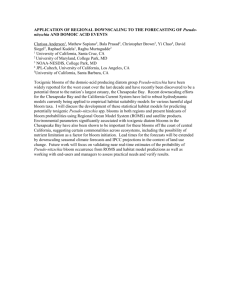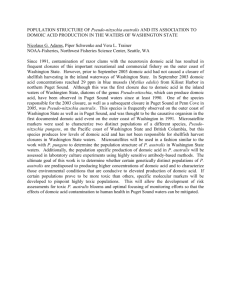The first illnesses and deaths in Washington State due to paralytic
advertisement
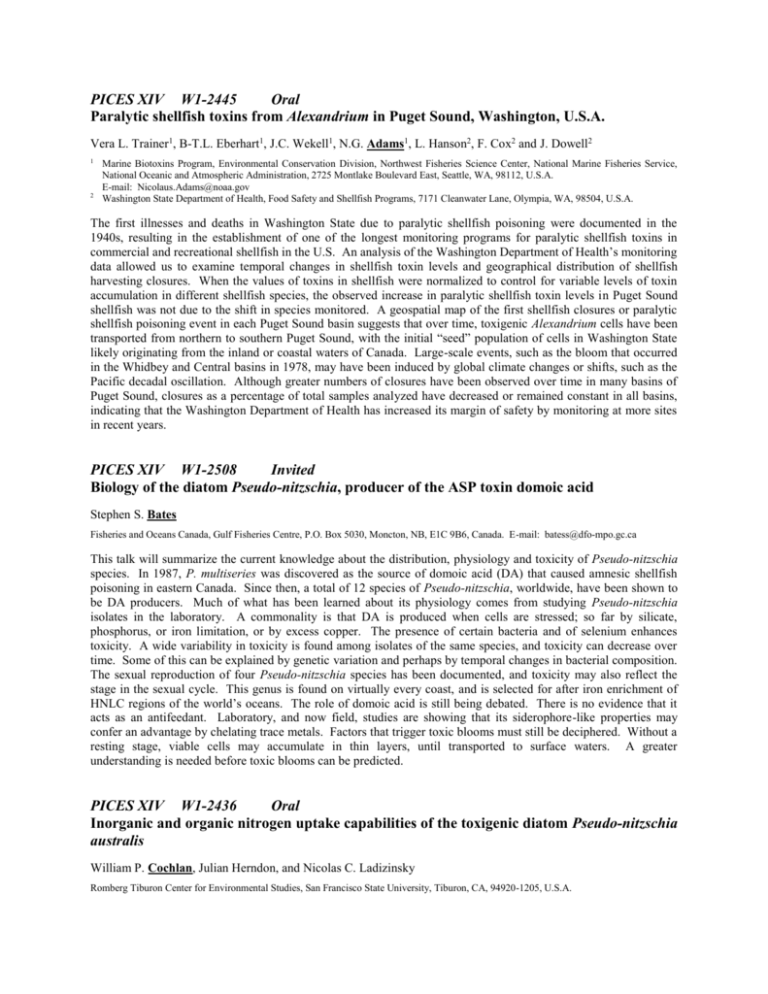
PICES XIV W1-2445 Oral Paralytic shellfish toxins from Alexandrium in Puget Sound, Washington, U.S.A. Vera L. Trainer1, B-T.L. Eberhart1, J.C. Wekell1, N.G. Adams1, L. Hanson2, F. Cox2 and J. Dowell2 1 2 Marine Biotoxins Program, Environmental Conservation Division, Northwest Fisheries Science Center, National Marine Fisheries Service, National Oceanic and Atmospheric Administration, 2725 Montlake Boulevard East, Seattle, WA, 98112, U.S.A. E-mail: Nicolaus.Adams@noaa.gov Washington State Department of Health, Food Safety and Shellfish Programs, 7171 Cleanwater Lane, Olympia, WA, 98504, U.S.A. The first illnesses and deaths in Washington State due to paralytic shellfish poisoning were documented in the 1940s, resulting in the establishment of one of the longest monitoring programs for paralytic shellfish toxins in commercial and recreational shellfish in the U.S. An analysis of the Washington Department of Health’s monitoring data allowed us to examine temporal changes in shellfish toxin levels and geographical distribution of shellfish harvesting closures. When the values of toxins in shellfish were normalized to control for variable levels of toxin accumulation in different shellfish species, the observed increase in paralytic shellfish toxin levels in Puget Sound shellfish was not due to the shift in species monitored. A geospatial map of the first shellfish closures or paralytic shellfish poisoning event in each Puget Sound basin suggests that over time, toxigenic Alexandrium cells have been transported from northern to southern Puget Sound, with the initial “seed” population of cells in Washington State likely originating from the inland or coastal waters of Canada. Large-scale events, such as the bloom that occurred in the Whidbey and Central basins in 1978, may have been induced by global climate changes or shifts, such as the Pacific decadal oscillation. Although greater numbers of closures have been observed over time in many basins of Puget Sound, closures as a percentage of total samples analyzed have decreased or remained constant in all basins, indicating that the Washington Department of Health has increased its margin of safety by monitoring at more sites in recent years. PICES XIV W1-2508 Invited Biology of the diatom Pseudo-nitzschia, producer of the ASP toxin domoic acid Stephen S. Bates Fisheries and Oceans Canada, Gulf Fisheries Centre, P.O. Box 5030, Moncton, NB, E1C 9B6, Canada. E-mail: batess@dfo-mpo.gc.ca This talk will summarize the current knowledge about the distribution, physiology and toxicity of Pseudo-nitzschia species. In 1987, P. multiseries was discovered as the source of domoic acid (DA) that caused amnesic shellfish poisoning in eastern Canada. Since then, a total of 12 species of Pseudo-nitzschia, worldwide, have been shown to be DA producers. Much of what has been learned about its physiology comes from studying Pseudo-nitzschia isolates in the laboratory. A commonality is that DA is produced when cells are stressed; so far by silicate, phosphorus, or iron limitation, or by excess copper. The presence of certain bacteria and of selenium enhances toxicity. A wide variability in toxicity is found among isolates of the same species, and toxicity can decrease over time. Some of this can be explained by genetic variation and perhaps by temporal changes in bacterial composition. The sexual reproduction of four Pseudo-nitzschia species has been documented, and toxicity may also reflect the stage in the sexual cycle. This genus is found on virtually every coast, and is selected for after iron enrichment of HNLC regions of the world’s oceans. The role of domoic acid is still being debated. There is no evidence that it acts as an antifeedant. Laboratory, and now field, studies are showing that its siderophore-like properties may confer an advantage by chelating trace metals. Factors that trigger toxic blooms must still be deciphered. Without a resting stage, viable cells may accumulate in thin layers, until transported to surface waters. A greater understanding is needed before toxic blooms can be predicted. PICES XIV W1-2436 Oral Inorganic and organic nitrogen uptake capabilities of the toxigenic diatom Pseudo-nitzschia australis William P. Cochlan, Julian Herndon, and Nicolas C. Ladizinsky Romberg Tiburon Center for Environmental Studies, San Francisco State University, Tiburon, CA, 94920-1205, U.S.A. E-mail: cochlan@sfsu.edu The nitrogen uptake capabilities of the toxigenic diatom Pseudo-nitzschia australis were examined in uni-algal laboratory cultures at saturating photosynthetic photon flux densities (100 µE m-2 s-1) and 15°C. The kinetics of nitrogen (nitrate, ammonium, urea and glutamine) uptake as a function of substrate concentration were estimated from short (10-min) incubations using the 15N-tracer technique, and are compared to the long-term exponential growth rates of P. australis determined in semi-continuous, batch cultures grown on the various nitrogen substrates. Based on the estimated nitrogen uptake kinetic parameters, nitrate is the preferred nitrogen substrate at both saturating and sub-saturating concentrations, whereas rates of urea uptake by P. australis did not saturate even at concentrations as high as 36 g-at N L-1. The growth rate (determined using cell abundance over time) of P. australis was slower for cells grown on urea (0.5 d -1) compared to the cells grown on nitrate and ammonium, which both maintained significantly greater growth rates (ca. 0.9 d-1). However, the particulate domoic acid content of the ureagrown cells was substantially greater than cells grown on either nitrate or ammonium. These results demonstrate the capability of this diatom to grow equally well on both oxidized and reduced forms of nitrogen, supporting our field observations that P. australis blooms during both upwelling and non-upwelling conditions off the west coast of North America. During these times, substantial differences in the nitrogenous nutrition of P. australis can be expected, and anthropogenic inputs of reduced N substrates could contribute significantly to its growth and toxicity. PICES XIV W1-2266 Oral Notes on Pseudo-nitzschia and Alexandrium bloom occurrence in Japanese coastal waters Shigeru Itakura, Satoshi Nagai, Yukihiko Matsuyama and Mineo Yamaguchi Harmful Algal Bloom Division, National Research Institute of Fisheries and Environment of Inland Sea, Maruishi, Ohno-cho, Saeki-gun, Hiroshima, 739-0452, Japan. E-mail: itakura@affrc.go.jp In Japanese coastal waters, both Pseudo-nitzschia and Alexandrium species occur. Pseudo-nitzschia is one of the common phytoplankton in Japanese waters. However, in spite of intensive surveys conducted by the Fisheries Agency and several universities since 1993, domoic acid contamination (excess of quarantine level) in wild and aquacultured shellfish has not been detected so far. Therefore, only a few monitoring programs are set for ASP toxins in Japanese coastal waters. In contrast, PSP toxin contamination by Alexandrium (A. tamarense, A. catenella and A. tamiyavanichii) has been widely detected and an active monitoring program has been implemented for PSP toxins in Japanese coastal waters by the regional fisheries research organizations. Among the above three Alexandrium species, A. tamarense and A. catenella appear over a wide area and often cause toxin contamination in shellfish. From a morphological and genetic point of view, A. tamarense and A. catenella are closely related species, but these two species usually bloom in different areas in different seasons; rarely blooming simultaneously. Studies on these two Alexandrium species clarified that while they have the same life cycle (cyst and vegetative stages), their ecological and physiological characteristics are different. For example, duration of the cyst dormant period varies between A. tamarense (several months to half year) and A. catenella (several days to one week). Moreover, the temperature "window" for the cyst germination differs between A. tamarense (7.5˚C to 20˚C) and A. catenella (7.5˚C to 25˚C). These differences in cyst dormancy-germination characteristics would partly lead to spatial and temporal differentiation of blooming events. PICES XIV W1-2597 Oral Occurrence of Pseudo-nitzschia and Alexandrium species in Korean coastal waters Changkyu Lee, Ensub Cho, Jongkyu Park, Changhoon Kim, Wolae Lim and Giyoung Kwon Marine Harmful Organisms Research Team, National Fisheries Research and Development Institute, Sirangri 408-1, Gijangun, Gijangeup, Busan, 619-902, Republic of Korea. E-mail: cklee@nfrdi.re.kr A twelve-month field survey of the potentially toxic genus Pseudo-nitzschia was carried out in Chinhae Bay, an area of commercial culturing and harvesting of oysters. Ten species of Pseudo-nitzschia were identified during the study: Pseudo-nitzschia multiseries, P. pungens, P. multistriata, P. delicatissima, P. cuspidata, P. subfraudulenta, P. granii, P. fraudulenta, P. subpacifica, and an unidentified Pseudo-nitzschia sp. Pseudo-nitzschia pungens had the highest cell abundance, followed by P. delicatissima and P. multistriata. Although Pseudo-nitzschia species varied depending on month and sampling site, most were present at higher cell densities in lower temperature waters except for Pseudo-nitzschia multistriata. The motile cells of Alexandrium tamarense, PSP-producing species, appeared in January and reached their high concentration from March to May. Mussels became toxic in February and showed the highest level of toxicity from April to May. Alexandrium resting cysts were also found at every station surveyed, but the abundance was greatly variable depending on locality. Cyst collected in different seasons showed a large difference in the germination rate with showing relatively higher frequency in the cold water season; 9% (Oct.), 73% (Jan.), 68% (Apr.), and 44% (Jul.). Germination of Alexandrium resting cysts in Chinhae Bay was assumed to be largely controlled by the seasonal rhythmic pattern. PICES XIV W1-2288 Oral The distribution and HAB formation of Pseudo-nitzschia pungens in Chinese coastal waters Ruixiang Li and Mingyuan Zhu First Institute of Oceanography, SOA, 6 Xianxialing Road, Qingdao, 266061, P.R. China. E-mail: liruixiang@fio.org.cn Pseudo-nitzschia pungens in is a common and important species of phytoplankton in Chinese coastal waters. There were 5 recorded HABs caused by Pseudo-nitzschia pungens. In Bohai Sea, it is abundant in spring. In the Yellow Sea, high cell numbers appear in spring or early summer. High cell numbers occur in the East China Sea in early autumn or winter. In the South China Sea, Pseudo-nitzschia pungens is most abundant in the coast waters of Guangdong Province. Harmful blooms of Pseudo-nitzschia pungens usually are located south of Changjiang River (Yangtze River) Estuary. A Pseudo-nitzschia pungens HAB was found in upwelling area of Zhejiang Province in Aug. 1981. Two other blooms occurred in the western region of coastal water of Xiamen City in June 1987 and Dapeng Bay in Guangdong, respectively. These HAB’s consisted of Pseudo-nitzschia pungens but also included other diatom species. It is reported that Pseudo-nitzschia pungens can be toxic, however, domoic acid has not been found in Chinese strains. PICES XIV W1-2572 Oral Microsatellite markers reveal population genetic structure of the toxic dinoflagellate Alexandrium tamarense (Dinophyceae) in Japanese coastal waters Satoshi Nagai Harmful Algal Bloom Division, National Research Institute of Fisheries and Environment of Inland Sea, Maruishi, Ohno-cho, Saeki-gun, Hiroshima, 739-0452, Japan. E-mail: snagai@affrc.go.jp Transport of vegetative cells and resting cysts of the toxic dinoflagellate, Alexandrium tamarense (Lebour) Balech, which is responsible for paralytic shellfish poisoning (PSP), either in ships’ ballast water or via translocation of shellfish stocks has been proposed as an explanation for its global increase. However, the extent of contribution to the apparent “cosmopolitanism” of this species could not be assessed, as techniques to distinguish unambiguously between populations were insufficient to test dispersal theories. However, recently highly polymorphic microsatellite markers have been developed to investigate the genetic structure of A. tamarense populations. Here we analyzed nine microsatellite loci among 10 samples along with Japanese and Korean coasts. The nine microsatellites varied widely in number of alleles and gene diversity across populations. The analysis revealed that Nei’s genetic distance correlated significantly with geographic distance in pairwise comparisons, and there was genetic differentiation in about half of 45 pairwise populations, clearly indicating genetic isolation among populations in compliance with geographic distance and restricted gene flow by natural dispersal through tidal currents among the populations. On the other hand, high P-values in Fisher’s combined test were detected in 5 pairwise populations, indicating the similar genetic structure and the close relationship genetically. These findings suggest that disturbance of genetic structures of A. tamarense populations by human activity and gene flow by a human-assisted dispersal have occurred between these populations. PICES XIV W1-2281 Oral Species of the genera Alexandrium and Pseudo-nitzschia from the east coast of Russia Tatiana Orlova, Marina Selina and Inna Stonik Institute of Marine Biology, FEBRAS, 17 Palchevskogo Street, Vladivostok, 690041, Russia. E-mail: torlova@imb.dvo.ru Species of the genera Alexandrium and Pseudo-nitzschia from the east coast of Russia were studied by light and electron microscopy using field material and cultures. Ten Pseudo-nitzschia species were found: P. pungens, P. multiseries, P. multistriata, P. calliantha, P. americana, P. cf. pseudodelicatissima, P. delicatissima, P. fraudulenta, P. cf. heimii, and P. seriata f. seriata. The bloom-forming species were P. pungens, P. multiseries, P. calliantha, and P. americana, widely distributed along the Russian Pacific coast. Species P. seriata f. seriata and P. cf. heimii were observed only in Aniva Bay (the Sea of Okhotsk) at low densities. P. delicatissima was common but not numerous component of phytoplankton in study area. Eight species of the genus Alexandrium were recorded from the east coast of Russia: A. tamarense, A. acatenella, A. catanella, A. ostenfeldii, A. insuetum, A. pseudogonyaulax, A. margalefi and A. tamutum. Eight Alexandrium species were observed in the coastal waters of Sakhalin Island. Six species (excluding A. catenella and A. tamutum) were found in Peter the Great Bay of the Sea of Japan. Only three species A. tamarense, A. ostenfeldii and A. acatenella were observed in the coastal waters of Kamchatka and in the Bering Sea. It was shown that A. tamarense is dominant and the most widespread Alexandrium species on the Russian Pacific coast. Twenty six clones of Alexandrium tamarense and two clones of P. multiseries and P. calliantha were analyzed by HPLC. All of the isolates, excluding P. calliantha, were found to be toxic. PICES XIV W1-2422 Invited Occurrence and effects of Alexandrium species in the environs of the North Pacific Charles G. Trick Schulich School of Medicine, University of Western Ontario, Department of Biology, Room 402, North Campus Building, London, ON, N6A 5B7, Canada. E-mail: trick@uwo.ca The distribution and occurrence of the historically significant red tide dinoflagellate, Alexandrium sp. will be reviewed. Using taxonomic observations, levels of PSP toxins in marine organisms and records of the health affects of consuming contaminated shellfish, I will consider the historical variability of this genus in the waters of the North Pacific ecosystem. From these geographic examples a comparison will be made to the intensively studied Alexandrium sp. blooms from other global locations to assess the probability that the North Pacific populations are controlled and transported through seed-bed reservoirs or through deep water lenses of cells or cysts or through transport of ballast waters. I will also review the contrasting mechanisms of species competition – survival and physiological dominance at relatively low community densities - and the variability of toxin content in both the cells and cysts, with emphasis on correlations to specific hydrodynamic features of individual North Pacific populations. Our understanding of the relationship between toxicity, toxin composition, physiological state and genotype we assist in our contribution to human health issues associated with Alexandrium species. PICES XIV W1-2236 Oral Preliminary study of Pseudo-nitzschia spp. in the Yangtze estuary (China) Jinhui Wang1,3, Nina Lundholm2, Øjvind Moestrup2, Yutao Qin1 and Ren Xu1 1 2 3 East China Sea Environmental Monitoring Center, SOA, Dongtang road 630, Shanghai, 200137, P.R. China. E-mail: wfisherd@online.sh.cn University of Copenhagen, Strandpromenaden 5, DK-3000 Helsing r, Denmark School of Environmental Science and Engineering, Shanghai Jiao Tong University, Shanghai, 200240, P.R. China A four-season field survey of harmful algae including Pseudo-nitzschia was carried out in the Yangtze estuary (China) during 2003-2004. Three species of Pseudo-nitzschia were identified during the monitoring; P. multiseries, the first recorded in China, P. multistriata, the first recorded in the Yangtze estuary, and Pseudo-nitzschia pungens, which had been frequently detected. Pseudo-nitzschia spp. were distributed mainly in the outer region of the Yangtze river front, where the salinity was near 25 psu and the temperature 20°C on June. Pseudo-nitzschia spp. were found in highly turbid waters, even up to 802 mg/L, but cell numbers were highest in higher temperature, low turbidity waters. Among the 6 Pseudo-nitzschia species recorded to date in Chinese coastal waters, P. multistriata, P. multiseries and P. pseudodelicatissima have been documented elsewhere in the world as domoic acid producers. Mouse bioassays of mussels from the Yangtze estuary indicate the presence of the ASP toxin, but the existence of domoic acid still needs to be ascertained by HPLC analysis. A preliminary study during the 1980s found only P. pungens in these waters, indicating that P. multistriata and P. multiseries might be alien species in the Yangtze estuary. Pseudo-nitzschia spp. occurred in almost all the diluted waters of the Yangtze estuary, but also were relatively high in upwelling waters. Cell abundances were slightly higher in surface water than near the bottom. Seasonal fluctuations of Pseudo-nitzschia spp. indicate higher abundances in summer and autumn than in spring and winter. PICES XIV W1-2289 Oral The distribution and HAB formation of Alexandrium spp. in Chinese coastal waters Ruixiang Li and Mingyuan Zhu First Institute of Oceanography, SOA, 6 Xianxialing Road, Hi-tech Industrial Park, Qingdao, 266061, P.R. China E-mail: myzhu@public.qd.sd.cn Alexandrium tamarense and Alexandrium catenella, two PSP-producing species, are both common species of the genus Alexandrium in Chinese coastal water. PSP poisoning events caused by these two species are found in coastal waters of the world as well as in Chinese coastal waters. HABs of Alexandrium sp. usually occur in South China coastal waters, such as coastal waters of Fujian and Guangdong Provinces. However, these HABs have expanded northwards along the coast in recent years. There were blooms of Alexandrium sp. in area near Zhoushan Archipelago in the spring of 2002 and 2004, together with Prorocentrium dentatum. During these two HABs, cell numbers of Alexandrium sp. reached 106 cells/L. In Oct. 2004, a HAB of Alexandrium spp. occurred in coastal waters of Dalian City in North Yellow Sea. As Alexandrium spp. are toxic, these blooms are of concern to the Chinese government and scientists. Monitoring of HABs and toxicity in shellfish products therefore has been strengthened in Chinese coastal waters.
